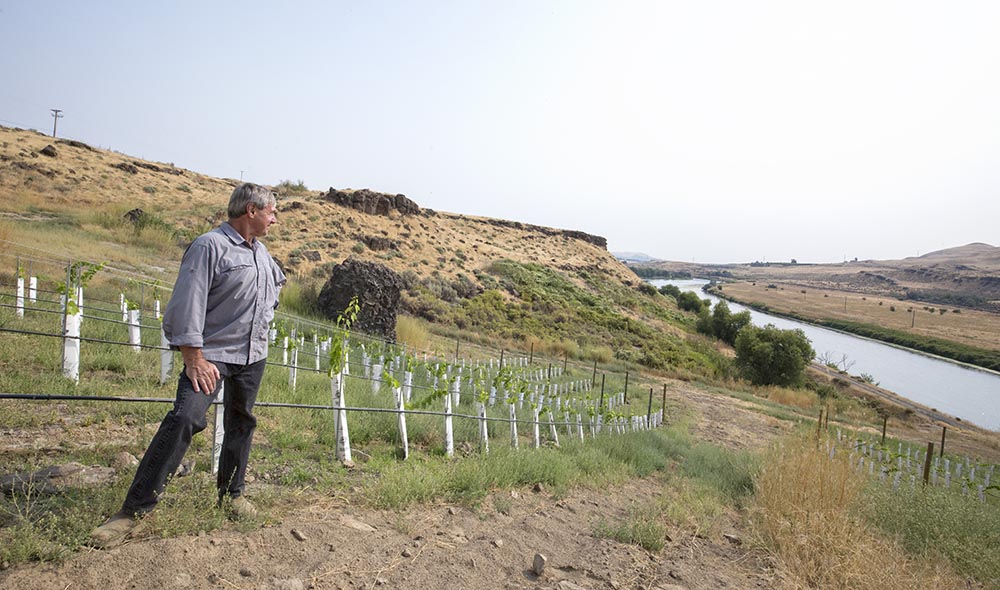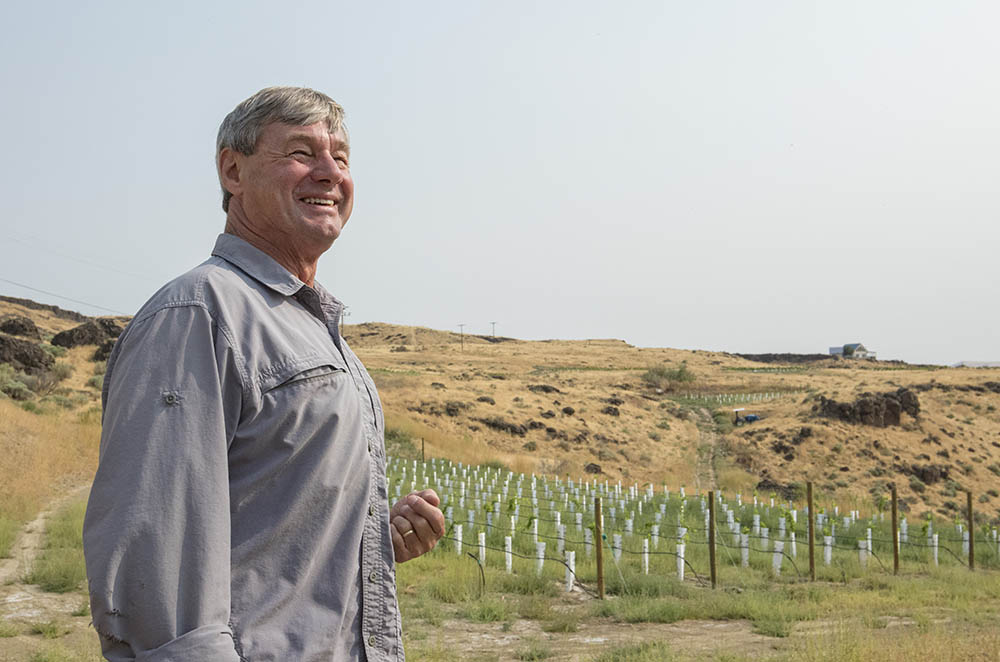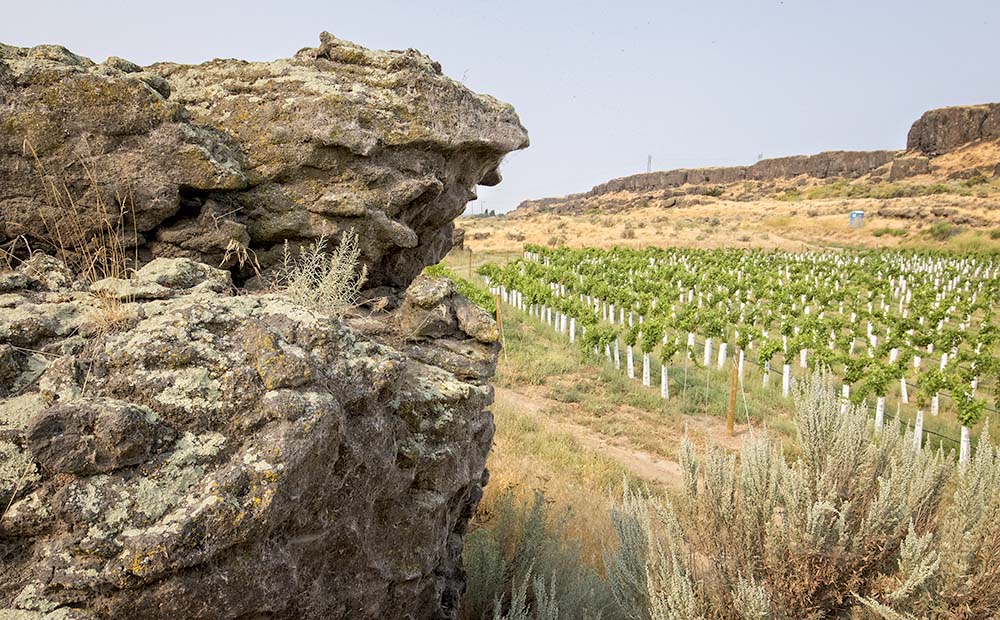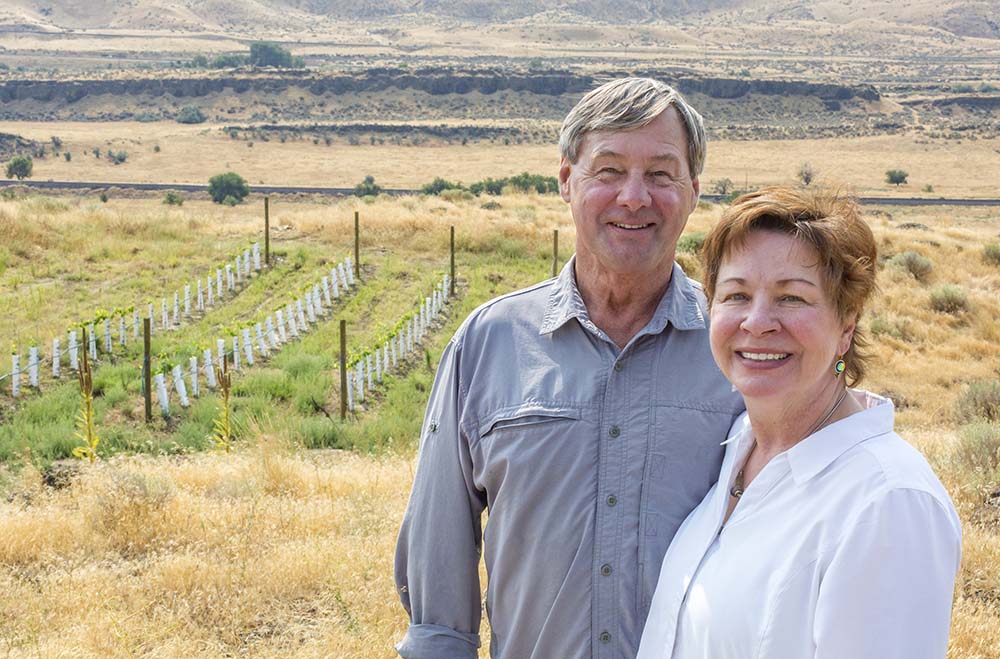
Larry Pearson looks out over a couple of the 10 different vineyard blocks wedged in between the Yakima River and basalt cliffs along the Old Inland Empire Highway north of Benton City, Washington, on August 22, 2017. (TJ Mullinax/Good Fruit Grower)
If you were looking for the most profitable place to plant a new vineyard, you would not start with the rocky cliffs above Washington’s Yakima River. But Larry Pearson feel in love with these rugged badlands and the river vistas nearly 20 years ago.
“What spoke to me about it was just the magical sense of it, walking amongst the sage in this rugged terrain and enjoying the river,” said Pearson, a longtime grower in the Red Mountain appellation, which is known for its bold reds.
Pearson purchased this nearby property, just west of Red Mountain, in the early 2000s on a whim.
A few years ago, he got serious about carving a home for premium wine grapes on the site he fondly calls the rock property. Making it farmable required some significant reshaping.
The site may be extreme, but across Washington, more growers are turning to challenging, rocky sites to plant new vineyards because “they are just running out of good dirt,” said Dennis Myers, an excavator based in Prosser, Washington, who works almost exclusively in vineyard site prep. “The land we’ve got left was someone else’s trash. So that’s what we do is come in and fix it for them.”
The summer after Myers excavated Pearson’s property, young vines were reaching toward the top wires in small blocks nestled between volcanic outcrops.

The soil they are rooting into is a fine silt, deposited by the wind in deep banks behind those outcrops that had to be spread out to create the blocks.
And rocks, so many rocks, had to be moved to make room for roots and tractor tracks that, in some places, the only place left to put them was in spaces along vine rows.
A whim
Pearson drove past this site nestled next to the river regularly as he commuted from his Red Mountain vineyards in southeast Washington to his day job west of the Cascade Range as a road engineer.
When Benton County offered the site up in a surplus property sale, he bit.
Developing it was another story.
“He’s been talking about this since I’ve known him and I never really thought it would happen, because there was no water out here, with it being so remote and so expensive to drill a well,” said his wife, Jane, an artist who runs the marketing for the winery and manages the tasting room. “Once that water showed up, kaboom.”

Larry Pearson looks out over a couple of the 10 different vineyard blocks of Cabernet Sauvignon and Aglianico growing in a rocky basalt terrain within the Yakima Valley appellation. (TJ Mullinax/Good Fruit Grower)
As unlikely as it sounds, in a way, water did just show up. By chance, Pearson drove by the site one day when a Benton Irrigation District crew was using it — without his permission — to access the rail line along the river where they were planning to build a pressurized line.
He contacted the district and bought the rights to water for 7 acres, tapping into the new line along his property that offered enough power to push water up to his vineyards without pumps.
Once he started to pay for that water, the site had to go from vision to reality. Now retired from engineering, he launched into planning the site, skipping recommended practices such as soil tests and surveying in favor of intuition gained from years spent exploring the site.
That’s Pearson’s style — he bought his first small plot on Red Mountain in 1984 after camping out there in search of an ideal spot to grow Cabernet Sauvignon.
In the badlands, the soil felt familiar — a very fine, wind-deposited silt similar to Red Mountain. The bigger challenge was highly variable soil depth and plenty of rocks.

The rocky terrain posed a challenge for Pearson and his crews, who worked around and over trouble spots to irrigate and install trellises. (TJ Mullinax/Good Fruit Grower)
So Pearson called in Myers.
“It was an aggressive site, with not much soil and a lot of rock,” Myers said, adding that he was initially hesitant about getting enough productive land out of the project to make it worth it. “But on the other hand, he had a vision and it was up to us to make it happen for him.”
Constrained by the same stark geology that drew Pearson to the property in the first place, the badlands required extensive, expensive site work to make it a good home for grapes. “The land is going to tell you what you are going to do,” Pearson said.
Today, the final design includes 10 blocks of varying sizes and orientations, some in bowls and some on slopes, following both the lay of the land and the laws of the county.
Meeting county codes required changing some of his initial vision for the site, Pearson said, which had focused on the vines first. But a vineyard needs to work logistically as well: think truck access, loading areas, a shop and a well and septic system for a future building to host guests or wine club events.
It took a “careful dance” to find spots for the grape loading area, shop and building after the site prep was already underway, Pearson said.
Distinct grapes for a distinct site
All that site preparation didn’t prevent planting headaches. Some rows stop short due to shallow rock, and one block lacks posts for now, because workers weren’t able to dig them in.
There’s even a tiny plot tucked into a swale holding 60 vines that got rock-blocked from their planned planting spot.
All told, the 10 blocks comprise about 6 acres. Pearson had hoped to squeeze in 7.

The site along the Yakima River features several volcanic rock formations covered in lichen, native grasses and sagebrush. (TJ Mullinax/Good Fruit Grower)
“In a very real way, an issue was that land prep cost a lot per acre and we only got 6 acres out of it, if that. That was like, ‘oof.’ That was a big thing to accept. So you might be inclined to say, ‘If we’re not going to get 10 acres out of 40, it’s not going to fly.’ But we didn’t do that analysis,” Pearson continued, laughing with Jane. “We found these areas that were very unique and could grow things, so that’s what we’re going to do.”
The branding for future single-vineyard wines captures the site’s story: The Badlands – A Tapteil Vineyard.
Tapteil is a small production winery, making about a thousand cases a year. Pearson sells most of his 32 acres of grapes on Red Mountain to other wineries.
On the badlands site, Pearson planted Cabernet Sauvignon and Aglianico, an Italian red that was a favorite on their recent trip to southern Italy.
“What I was looking for was Cab, for one, because I grow it, I know it, and I know it’s going to do fine, and then it was like, this is a unique site, let’s do something really different,” Pearson said.
He settled on Aglianico, a black grape best known in southern Italy, when he found it was available in Washington and heard that another grower in the area was having success with it.

Larry and Jane Pearson stand in front of one of the small plots of Aglianico they planted at their new Badlands Vineyard. The grape is a dark red originating from the Campania and Basilicata region in southern Italy. (TJ Mullinax/Good Fruit Grower)
There’s still a lot to learn about how to grow this new variety and how to manage such small, variable blocks. Most of the second-year Cabernet vines look vigorous and ready for training into a VSP system.
By August, the Aglianico planted this spring finally outgrew the native weeds Pearson leaves in between rows to protect soils from wind erosion.
But along the edges of some blocks, you can see a few vines struggling too — likely because the soil gave way to rocks.
Tending to the young vines now, getting to know each nook and cranny of the site as he moves irrigation every day, Pearson feels a sense of relief and a sense of excitement.
“It’s OK, it’s growing, it’s vibrant, this is a real thing and it almost looks viable. So OK, this is going to work,” he said. “This is a challenge, but it’s such a unique and beautiful site that it’s captivating.”
Now all that remains is to grow grapes. •
New home for an ancient grape
Although its popularity dates back to ancient Rome, Aglianico is a relatively new grape to Washington, and it’s likely to appeal to fans of the region’s signature Cabernet Sauvignon.
“When you look at the description of the grape, it’s very dark, dense, high acid and tannin, and therefore long-lived,” Larry Pearson said, similar to the qualities that people love in Cabernet Sauvignon.
It’s grown primarily in the Basilicata and Campania regions of southern Italy, where the hot, dry climate and well-drained, volcanic soils are similar to the conditions in Eastern Washington.
– by Kate Prengaman






Gorgeous site and like early growers in a special area the Pearson’s are letting nature help the work
Great article about some very nice friends. Looking forward to seeing this site.
Ah Tapteil… There’s either a bottle (or more in your cellar) or there should be soon. An excellent wine by a resourceful, on task, dedicated grower.
Larry has always planned out his endeavors very throughly and the outcome has always been a success when it comes to growing grapes. He knows grapes and he knows wine.